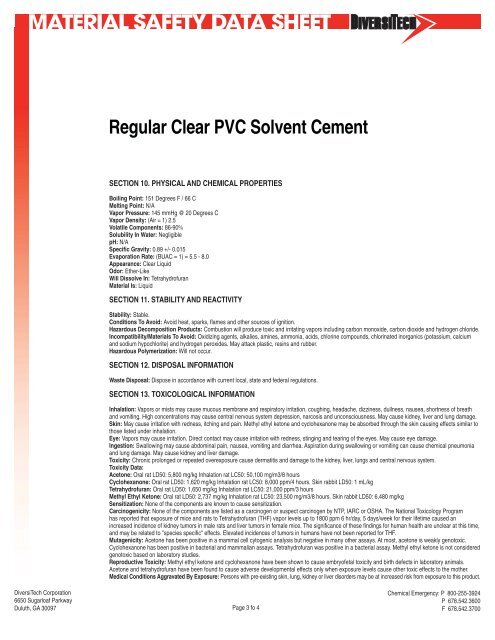Print MSDS - Miller Electric Company Publications
Print MSDS - Miller Electric Company Publications
Print MSDS - Miller Electric Company Publications
Create successful ePaper yourself
Turn your PDF publications into a flip-book with our unique Google optimized e-Paper software.
MATERIAL SAFETY DATA SHEET<br />
DiversiTech Corporation<br />
6650 Sugarloaf Parkway<br />
Duluth, GA 30097<br />
Regular Clear PVC Solvent Cement<br />
SECTION 10. PHYSICAL AND CHEMICAL PROPERTIES<br />
Boiling Point: 151 Degrees F / 66 C<br />
Melting Point: N/A<br />
Vapor Pressure: 145 mmHg @ 20 Degrees C<br />
Vapor Density: (Air = 1) 2.5<br />
Volatile Components: 86-90%<br />
Solubility In Water: Negligible<br />
pH: N/A<br />
Specific Gravity: 0.89 +/- 0.015<br />
Evaporation Rate: (BUAC = 1) = 5.5 - 8.0<br />
Appearance: Clear Liquid<br />
Odor: Ether-Like<br />
Will Dissolve In: Tetrahydrofuran<br />
Material Is: Liquid<br />
SECTION 11. STABILITY AND REACTIVITY<br />
Stability: Stable.<br />
Conditions To Avoid: Avoid heat, sparks, flames and other sources of ignition.<br />
Hazardous Decomposition Products: Combustion will produce toxic and irritating vapors including carbon monoxide, carbon dioxide and hydrogen chloride.<br />
Incompatibility/Materials To Avoid: Oxidizing agents, alkalies, amines, ammonia, acids, chlorine compounds, chlorinated inorganics (potassium, calcium<br />
and sodium hypochlorite) and hydrogen peroxides. May attack plastic, resins and rubber.<br />
Hazardous Polymerization: Will not occur.<br />
SECTION 12. DISPOSAL INFORMATION<br />
Waste Disposal: Dispose in accordance with current local, state and federal regulations.<br />
SECTION 13. TOXICOLOGICAL INFORMATION<br />
Inhalation: Vapors or mists may cause mucous membrane and respiratory irritation, coughing, headache, dizziness, dullness, nausea, shortness of breath<br />
and vomiting. High concentrations may cause central nervous system depression, narcosis and unconsciousness. May cause kidney, liver and lung damage.<br />
Skin: May cause irritation with redness, itching and pain. Methyl ethyl ketone and cyclohexanone may be absorbed through the skin causing effects similar to<br />
those listed under inhalation.<br />
Eye: Vapors may cause irritation. Direct contact may cause irritation with redness, stinging and tearing of the eyes. May cause eye damage.<br />
Ingestion: Swallowing may cause abdominal pain, nausea, vomiting and diarrhea. Aspiration during swallowing or vomiting can cause chemical pneumonia<br />
and lung damage. May cause kidney and liver damage.<br />
Toxicity: Chronic prolonged or repeated overexposure cause dermatitis and damage to the kidney, liver, lungs and central nervous system.<br />
Toxicity Data:<br />
Acetone: Oral rat LD50: 5,800 mg/kg Inhalation rat LC50: 50,100 mg/m3/8 hours<br />
Cyclohexanone: Oral rat LD50: 1,620 mg/kg Inhalation rat LC50: 8,000 ppm/4 hours. Skin rabbit LD50: 1 mL/kg<br />
Tetrahydrofuran: Oral rat LD50: 1,650 mg/kg Inhalation rat LC50: 21,000 ppm/3 hours<br />
Methyl Ethyl Ketone: Oral rat LD50: 2,737 mg/kg Inhalation rat LC50: 23,500 mg/m3/8 hours. Skin rabbit LD50: 6,480 mg/kg<br />
Sensitization: None of the components are known to cause sensitization.<br />
Carcinogenicity: None of the components are listed as a carcinogen or suspect carcinogen by NTP, IARC or OSHA. The National Toxicology Program<br />
has reported that exposure of mice and rats to Tetrahydrofuran (THF) vapor levels up to 1800 ppm 6 hr/day, 5 days/week for their lifetime caused an<br />
increased incidence of kidney tumors in male rats and liver tumors in female mice. The significance of these findings for human health are unclear at this time,<br />
and may be related to "species specific" effects. Elevated incidences of tumors in humans have not been reported for THF.<br />
Mutagenicity: Acetone has been positive in a mammal cell cytogenic analysis but negative in many other assays. At most, acetone is weakly genotoxic.<br />
Cyclohexanone has been positive in bacterial and mammalian assays. Tetrahydrofuran was positive in a bacterial assay. Methyl ethyl ketone is not considered<br />
genotoxic based on laboratory studies.<br />
Reproductive Toxicity: Methyl ethyl ketone and cyclohexanone have been shown to cause embryofetal toxicity and birth defects in laboratory animals.<br />
Acetone and tetrahydrofuran have been found to cause adverse developmental effects only when exposure levels cause other toxic effects to the mother.<br />
Medical Conditions Aggravated By Exposure: Persons with pre-existing skin, lung, kidney or liver disorders may be at increased risk from exposure to this product.<br />
Page 3 fo 4<br />
Chemical Emergency: P 800-255-3924<br />
P 678.542.3600<br />
F 678.542.3700



